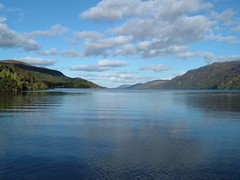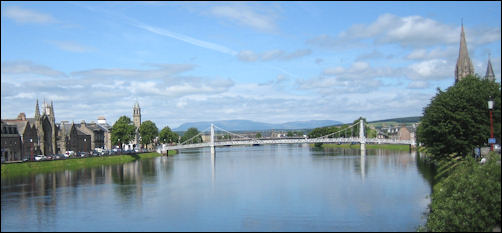Welcome to Scotland to see the most beautifull lake which also have the most amazing stories about the legendary creatures. Loch Ness is best known for the alleged sightings of the cryptozoological Loch Ness Monster, also known affectionately as "Nessie". Loch Ness lake is a large, deep, freshwater loch in the Scottish Highlands and is one of the most visited locations in Scotland. In fact it is the most famous lake in the world, loch being the Scottish word for lake or fiord. Loch Ness is a substantial body of water about 24 miles long by one mile wide and at its deepest point it goes down nearly 1,000 ft. There are about 40 small rivers, streams, burns and waterways running into the loch. Loch Ness lies at the northeast end of the Great Glen in the Highlands of Scotland and occupies a large part of the Great Glen fault. The Great Glen is a geological fault running across the entire width of the Highlands of Scotland. It runs southwest from Inverness right down to Fort William and contains three freshwater lochs - Loch Ness, Loch Oich and Loch Lochy.
The Loch ness is connected at the southern end by the River Oich and a section of the Caledonian Canal to Loch Oich. This canal enables boating craft to journey from the east coast to the west coast passing through stepped lock gates at Fort Augustus and at Fort William. Fort William is situated near the west coast on the sea loch Loch Linnhe and is overlooked by Ben Nevis, the highest mountain in the British Isles. The Caledonian Canal was built by Thomas Telford in 1803 and eventually opened in 1822. It has 29 lock gates to navigate along its 60 mile route. At the northern end there is the Bona Narrows which opens out into Loch Dochfour, which feeds the River Ness and a further section of canal to Inverness. It is one of a series of interconnected, murky bodies of water in Scotland; its water visibility is exceptionally low due to a high peat content in the surrounding soil.
 |
| Beautifull View of Loch Ness |
Loch Ness is an extremely narrow and long lake, extending from the northeast to the southwest in the Inverness area of north Scotland. The lake is about 39 km long, but only 1.5 km wide, and has a maximum depth of 230 m and a mean depth of 132 m. Loch Ness is about 52 ft above sea level and, because of its depth, it has a larger volume of water than any other Scottish loch - although Loch Lomond has a larger surface area it is not so deep. Loch Ness is said never to freeze and maintains the same temperature of about 4C throughout the year. It contains more fresh water than all lakes in England and Wales combined and is the largest body of water on the Great Glen Fault. Loch Ness is about 10,000 years old and was formed at the end of the last Great Ice Age during which The Great Glen had been filled with a huge glacier. The water becomes deep very quickly and the sides of the loch suddenly plunge vertically down into extremely murky water due to the high level of peat content - swimming is not recommended! Its water volume is the largest, and the surface area is the second largest next to Loch Lomond, in this country. The lake water flows out to Moray Firth through the Ness River. It is known as one of the most scenic lakes of this country, with an old ruined castle on the lakeside and surrounding mountain view.The drainage basin is still rich in woodlands and grasslands, having a low population density of 1.8 km-2. Nutrients inflow to the lake, therefore, is still in low level and the water remains oligotrophic and transparent. However, it is anxious that eutrophication may be caused by many tourists attracted by Nessy and by increasing activity of residents in the drainage basin.
 |
| Amazing View fro all side |
The watershed of Loch Ness covers more than 700 square miles (1,800 square km) and comprises several rivers, including the Oich and the Enrick. Its outlet is the River Ness, which flows into the Moray Firth at Inverness. Seiches (surface oscillations), caused by differential heating, are common on the loch. The sharp rise and fall of the level of the loch is one reason for the scanty flora of the waters; another reason is the great depths of the loch near the shoreline. The abyssal fauna is also sparse.
Like some other very deep lochs in Scotland and Scandinavia, Loch Ness is said to be inhabited by an aquatic monster. Many sightings of the so-called Loch Ness monster have been reported, Nessy is a world-famous unidentified organism and the possibility of its existence—perhaps in the form of a solitary survivor of the long-extinct plesiosaurs—continues to intrigue many. Investigations on Nessy have been carried out since 1962 by the Loch Ness Investigation, a voluntary organization with some scientists. Whether you believe in the Loch Ness monster or not, the sight of beautifull glacier-gouged Loch Ness and the crumbling ruins of Urquhart Castle, atop its own promontory. Is not to be missed.
There have been unconfirmed reports of a Loch Ness Monster since the 15th century, affectionately known as 'Nessie'. Enthusiasts trace the first sighting of the Loch Ness monster back to St Columba in the 6th century. His early biographer, St Adamnan, tells how he used the sign of the cross to repel a monster in the river Ness. Since then there have been numerous sightings which have been seriously reported and there have been many intensive scientific investigations. The Loch Ness Exhibition Centre in Drumnadrochit takes visitors through 500 million years of Loch Ness history using a highly effective mix of lasers, digital projection and special effects. It charts the history of the monster by exploring Scotland's geological past, its folklore and the various research projects carried out on the loch.
 |
| Is it for real that this creatures may exist?? |
How To Get To The Loch Ness
Loch ness is about 72 Miles from Inverness airport. So if you want to reach Loch Ness you must arrived first in Inverness. Inverness is linked to the Black Isle across the Moray Firth by the Kessock Bridge. It has a railway station with services to Perth, Edinburgh, Glasgow, London, Aberdeen, Thurso, Wick and to Kyle of Lochalsh. Inverness is connected to London by the Caledonian Sleeper, which departs six times a week and by the Highland Chieftain which runs 7 days a week. Inverness Airport is located 15 km east of the city and has scheduled flights to airports across the UK including London, Manchester, Belfast and the islands to the north and west of Scotland. Flybe operate flights to Gatwick, Manchester, Belfast, Birmingham, Southampton and Jersey. Loganair, Flybe's franchise partner, operate Saab 340 aircraft to Stornoway, Kirkwall, Sumburgh, Glasgow and Edinburgh.
 |
| Inverness, the gate to visit Loch ness |
Three trunk roads (the A9, A82 and A96) provide access to Aberdeen, Perth, Elgin, Wick, Thurso, Edinburgh and Glasgow.
Stagecoach Highlands is the division of the Stagecoach Group which covers most of the former Rapson Group operations after the take-over by Stagecoach. It covers the following depots of the Stagecoach Group.
- Fort William (Ardgour Road, Caol) (t/a Stagecoach in Lochaber)
- Kirkwall (Scott's Road Hatson Industrial Estate) (t/a Stagecoach in Orkney)
- Portree (Park Road) (t/a Stagecoach in Skye)
- Thurso (Janet Street) (t/a Stagecoach in Caithness)
There are various outstations over the division area due to the rural nature of the area covered.
The operation from Aviemore depot comes under the East Scotland division as it trades as Stagecoach in Inverness.
So Lets Enjoy Your Journey in Loch Ness and Lets Hope That You Can Meet The Legendary Creature Nessy.



 11:17 PM
11:17 PM
 Unknown
Unknown

 Posted in:
Posted in: 


0 comments:
Post a Comment